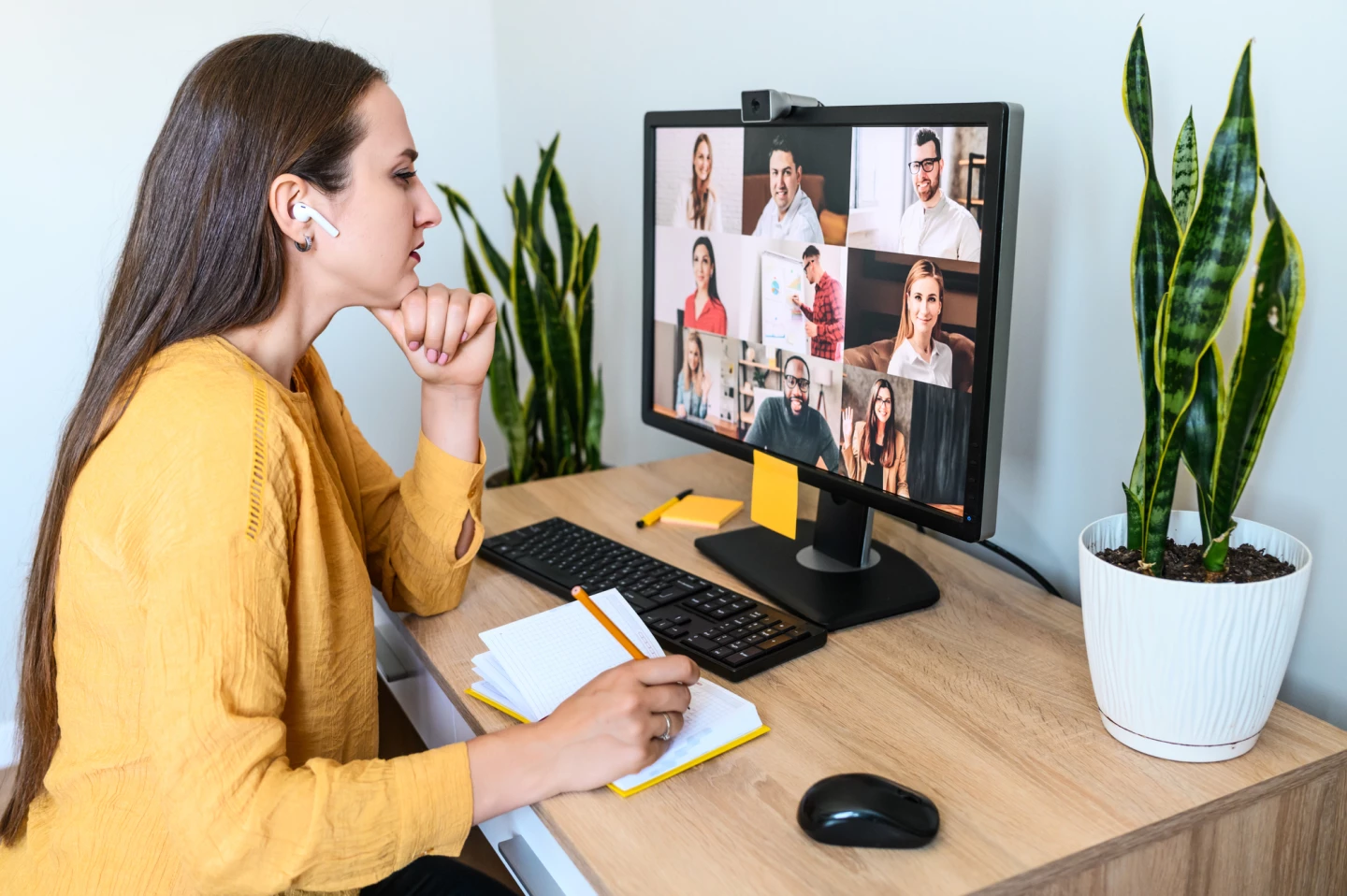A new study from Stanford University communications expert Jeremy Bailenson is investigating the very modern phenomenon of "Zoom Fatigue." Bailenson suggests there are four key factors that make videoconferencing so uniquely tiring, and he recommends some simple solutions to reduce exhaustion.
Videoconferencing is by no means a new technology. The dream of two-way audio-video communication goes back over a century. For the past decade particular innovations, such as Apple FaceTime and Skype, have swiftly turned a science fiction vision into the daily norm for many.
When the COVID-19 pandemic took hold in early 2020 and people shifted to living their lives from home, videoconferencing quickly became a primary mode of communication, for everything from seeing your doctor to taking a college class. Suddenly, hundreds of millions of people were spending most of their day sitting in front of a screen, watching an array of faces staring back at them, and the term "Zoom fatigue" soon emerged.
People were reporting a unique kind of exhaustion at the end of whole days of videoconferencing, which seemed counter-intuitive. After all, we could spend our entire day in the comfort of our own home instead of trekking around town from meeting to meeting. Why were we seemingly more exhausted after six or eight hours of videoconferencing compared to a regular long day of in-person interactions?
Jeremy Bailenson, founding director of the Virtual Human Interaction Lab at Stanford University, was not surprised. He had spent more than two decades studying the ways virtual communication affects individuals, and he quickly penned an editorial suggesting the unique fatigue that accompanies a day of videoconferencing could be due to a kind of non-verbal-cue overload that occurs when one substitutes virtual platforms for in-person interactions.
Now, Bailenson has comprehensively articulated his ideas in a new peer-reviewed perspective, published in the journal Technology, Mind, and Behavior. The research suggests four key reasons why video conferencing can be so unusually exhausting and offers several solutions to help make your day of "zooming" less tiring.
While obviously the kind of exhaustion Bailenson is referring to is not unique to Zoom specifically, he suggests the ubiquity of the software has led to “zoom” being commonly used as a synonym for videoconferencing, in much the same way "googling" is a general catch-all for using an internet search engine.
“I don’t do this to vilify the company – I am a frequent Zoom user, and I am thankful for the product which has helped my research group stay productive and allowed friends and family to stay connected,” explains Bailenson in the new study. “But given it has become the default platform for many in academia, and readers of this article are likely familiar with its affordances, it makes sense to focus on Zoom, which jumped from about 10 million users in December, 2019, to more than 300 million users 5 months later.”
Everyone is staring at you ... all the time

The first cause for Zoom Fatigue suggested by Bailenson is the state of stressed hyper-arousal generated by excessive stretches of close-up eye contact. Unlike an in-person meeting, where participants will shift from looking at a speaker to other activities, such as note taking, on Zoom everyone is always staring at everyone.
The anxiety generated by a number of faces staring at you can be likened to the stresses of public speaking but amplified to a degree regardless of who is talking. Bailenson explains, from a perceptual standpoint, Zoom turns every participant on a call into a constant speaker smothered with eye gaze.
Another factor at play compounding the stress of constant eye gaze can be the size of faces on your monitor. Landmark research from cultural anthropologist Edward Hall in the 1960s suggested interpersonal distance fundamentally influences emotion and behavior.
Summarizing Hall’s work for the digital age, Bailenson says a person’s intimate space spans a radius of about 60 cm (23 in). Interactions inside this space are generally reserved for family or intimate friends, but depending on your monitor size and Zoom settings, large faces of strangers can often be presented in close proximity.
“In general, for most setups, if it’s a one-on-one conversation when you’re with coworkers or even strangers on video, you’re seeing their face at a size which simulates a personal space that you normally experience when you’re with somebody intimately,” say Bailenson.
The short-term solutions to mitigate these issues are to reduce the size of your videoconferencing window, and try to move away from your computer monitor. The goal, Bailenson notes, is to increase the personal space between yourself and other Zoom participant’s faces.
The distraction of video

An influential 1999 study from Stanford University’s Pamela Hinds looked at the differences in cognitive processing between audio communication and audio-visual communication. Hinds paired up volunteers and presented them with two tasks designed to measure cognitive load; a guessing game task, and a subsequent recognition task.
The study revealed those subjects performing the tasks by audio only performed better on the secondary recognition task compared to those subjects completing the same tasks by videoconferencing.
The discrepancy was hypothesized to be a result of the increased cognitive load generated by video communication. The additional mental resources needed to interpret video cues means it takes more cognitive work to communicate.
Bailenson says the constant barrage of complex non-verbal cues, both being sent and received, during a Zoom interaction can be a major influence on the novel sense of fatigue generated by the technology. He suggests long Zoom meetings should require audio-only breaks, to help relieve the cognitive load of video interactions.
“This is not simply you turning off your camera to take a break from having to be nonverbally active, but also turning your body away from the screen,” explains Bailenson, “so that for a few minutes you are not smothered with gestures that are perceptually realistic but socially meaningless.”
You're so good looking ...
“Imagine in the physical workplace, for the entirety of an 8-hr workday, an assistant followed you around with a handheld mirror, and for every single task you did and every conversation you had, they made sure you could see your own face in that mirror,” Bailenson writes.
Perhaps the strangest part of modern videoconferencing is one’s reflection constantly staring back from the screen. For decades researchers have investigated the effect seeing oneself in a mirror has on prosocial behavior and self-evaluation.
In general this body of work suggests there may be a small negative affect generated by intensive mirror image viewing, and this is potentially underpinned by the way a reflection of oneself amplifies critical self-evaluation. But Bailenson points out this particular factor is perhaps the most profoundly understudied aspect of videoconferencing as most prior mirror-image research has only focused on the influence of seeing oneself for short periods of time.
“There is no data on the effects of viewing oneself for many hours per day,” he writes. “Given past work, it is likely that a constant mirror on Zoom causes self-evaluation and negative affect.”
So what's the solution? The answer is as simple as hiding the view of yourself during a Zoom call. Bailenson also recommends the platforms should not make the view of oneself a default option during video calls. Once you have sorted yourself in your frame, close your self-view window.
A highway-hypnotic semi-attentive fugue
Twenty-five years ago author David Foster Wallace’s epic novel Infinite Jest presented a stark picture of a future world. Among the novel’s many prescient observations, Wallace imagined a world where videophones were only popular for about a year.
Wallace suggested people would quickly revert back to audio-only communication once the novelty of video-calls had worn off. He figured one of the strengths of audio-only communication was how it enabled people to enter a fugue-like state where they wandered around doing other minor tasks while talking.
“A traditional aural-only conversation […] let you enter a kind of highway-hypnotic semi-attentive fugue: while conversing, you could look around the room, doodle, fine-groom, peel tiny bits of dead skin away from your cuticles, compose phone-pad haiku, stir things on the stove; you could even carry on a whole separate additional sign-language-and-exaggerated-facial-expression type of conversation with people right there in the room with you, all while seeming to be right there attending closely to the voice on the phone. And yet – and this was the retrospectively marvelous part – even as you were dividing your attention between the phone call and all sorts of other idle little fuguelike activities, you were somehow never haunted by the suspicion that the person on the other end’s attention might be similarly divided,” Wallace imagined back in 1996.
Bailenson points out a growing body of research is finding movement can improve cognitive performance. One recent study, for example, found walking on a treadmill can enhance creative divergent thinking compared to sitting.

Even in conventional face-to-face meetings people tend to move about the room, stand while presenting information, or pace around while thinking of new ideas. Zoom meetings, of course, can remove all of these locomotive factors and in some cases this can lead to less efficient meeting outcomes.
Here Bailenson suggests the medium a meeting is conducted in should be closely considered. Does every meeting need to be via Zoom? Is there a benefit to certain interactions moving back to audio-only platforms?
For meetings that need to take place on Zoom, Bailenson recommends creating more distance between oneself and the camera. This can be achieved through the use of an external camera, separate from a computer, generating personal distance that allows for one to move about a room.
We're through the looking glass
Zoom, and other videoconferencing technologies, have inarguably been incredible tools to help us all weather this global pandemic. It is difficult to even imagine how different things would have been if this pandemic occurred just 15 years ago.
And it is unlikely things will ever fully bounce back to how they were before the pandemic. Virtual meetings are now deeply woven into our social fabric. Videoconferencing in the past was a utilitarian choice, to be used in cases where there was no way to meet in person. But now, moving forward, these virtual behaviors have become so ingrained, so normalized, that Zoom meetings are set to become a permanent part of our lives.
Bailenson is frank in pointing out many of his conclusions in this new study are entirely hypothetical. But that is part of the point he is trying to make. Over the last year hundreds of millions of people have, on a massive scale, embraced a profoundly new form of communication. And we need to do the research to understand what potential negative effects there may be, and how we can be optimizing our use of this technology.
“While [these arguments] are based on previous research findings, almost none of them have been directly tested,” Bailenson concludes. “It is my hope that others will see many research opportunities here, and will run studies that test these ideas.”
The new study was published in the journal Technology, Mind and Behavior.
Source: Stanford University








